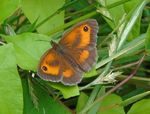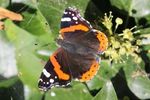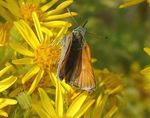THE BUTTERFLIES OF BREDFIELD - An annotated list of butterflies that may be seen in the vicinity of Bredfield.
←
→
Page content transcription
If your browser does not render page correctly, please read the page content below
THE BUTTERFLIES
OF BREDFIELD
An annotated list of butterflies that may be seen in the
vicinity of Bredfield.INTRODUCTION Bredfield does not contain any specialised butterfly habitats – such as heathland or large broad-leafed woodland – and the butterflies you will find in and around the village are those that are common or fairly common in Suffolk1. Most of the butterflies described here can be found in your garden. Indeed, you are much more likely to find butterflies in your garden that on the arable fields that surround the village. The Jubilee Meadow and Orchard is also a very good place for finding and watching butterflies. A few points of description are provided in this list, but you will need a Field Guide to be sure of identification. The best is: Richard Lewington: ‘Pocket Guide to the Butterflies of Great Britain and Ireland’ (BWP); which also contains a brief description of the caterpillar stage of each butterfly. This Bredfield list only describes the adult stage. In some species – e.g. Orange Tip, Meadow Brown and Common Blue – male and female look different; while in other species – e.g Peacock and Small Tortoiseshell – the sexes are alike. The list provided here contains the butterflies that you are likely to see in Brefield (and even some of these – like Purple Hairstreak – cannot be expected to be seen regularly). Some species are in decline and, where you might have seen them in Bredfield in years past, they would be a rare sighting today. White-letter Hairstreak and White Admiral are examples in case. Some rare species are slowly expanding their range and numbers. Silver-washed Fritillary has been seen in Bredfield in recent years. Clouded Yellow is a migratory species which may come to Bredfield if there is a very large influx. Some other species – Greyling, Brown Argus, Green Hairstreak - are much more likely to seen on the other side of the A12, where there is heathland and the soil is sandy. Please report interesting butterfly sightings through the Bredfield: Wildlife Friendly Village website or our group Facebook page. 1 The common butterflies that may be seen in Bredfield largely coincide with those found in 100+ tetrads in the Suffolk butterfly monitoring scheme.
HESPERIIDAE
ESSEX SKIPPER
Skippers hold their wings in a manner that makes them resemble moths. Essex Skipper looks very
similar to the following species and, without close exanimation, it is almost impossible to tell them
apart. The distinguishing feature is that Essex Skipper has black on the underside of the tip of the
antennae. This species can be found in the Jubilee Meadow and Orchard between June and August.
SMALL SKIPPER
Very similar to the above species, but with orange under the tip of the antennae. On the wing between
June and August.
LARGE SKIPPER
Clearly larger that the above two species. It can be found in the Jubilee Meadow and Orchard, and in
your garden, between June and August.
Essex Skipper Small Skipper Large Skipper
PIERIDAE
ORANGE TIP
An attractive small white butterfly. The male has bright orange wing tips. It usually rests with wings
closed, when the green markings on the underwing make it more difficult to see. A fairly common
species that is on the wing between April and July.
LARGE WHITE
A familiar garden butterfly, distinguished from the following species not only by its larger size, but by
the more extensive black marking on the wing tips. Flight period is between April and September.
SMALL WHITE
Another familiar garden butterfly: smaller than the above species with different markings on the
wing tips. Flight period is between April and September.
GREEN-VEINED WHITE
A less familiar white butterfly, distinguished by the eponymous green vein patterning in the wing.
Flight period is between April and September.BRIMSTONE
One of the first butterflies to be seen on the wing; even a bright February day will attract these
bright green gems to be out and about. They are energetic flyers that may pass through your
garden, but rarely settle.
Orange tip Large white Small White
Green-veined White Brimstone
NYMPHALIDAE
SPECKLED WOOD
Almost always seen around the margins of woods and shrubby area. If you visit the Jubilee Meadow
and Orchard, expect to find them near the trees and hedges by the entrance path, rather than in the
meadow itself. Flight period is April to October.
SMALL HEATH
A small and not strongly marked butterfly which frequents open spaces. It can be found in the
meadow between May and September.
RINGLET
A dark brown butterfly with characteristic buffy-yellow rings on the wing. More likely to be seen
around hedges and woodland margins. Flight period: June to August.
MEADOW BROWN
A common and widespread species that is sometimes confused with the following species if not seen
clearly (see below). Flight period between late May to September.GATEKEEPER
A common and widespread species, sometimes known as Hedge Brown. It is smaller and brighter
than the Meadow Brown, with which it often consorts. This species has two white ‘pupils’ in the
dark eye-spot, whereas the Meadow Brown has only one. On the wing, June to early-September.
SILVER-WASHED FRITILLARY
A beautiful, but rare butterfly which appears to be making a comeback and expanding its range. It
has been seen recently in Bredfield. July and August are the months to look out for this species.
RED ADMIRAL
A common, widespread and familiar species. On the wing, March to October.
PAINTED LADY
A migratory species; more common in some years that others. Not uncommon in Bredfield. It can
be seen on the wing between late-April to October.
PEACOCK
A common species and one of the first to be seen on the wing in early-Spring. Over the winter
period, you might find one hibernating in your shed or garage. On the wing for most the year. The
caterpillars thrive on nettles.
SMALL TORTOISESHELL
A fairly common and familiar species, though numbers in Suffolk appear to be declining. This species
can be found throughout the spring and summer, and is also to be seen in gardens in late Autumn.
COMMA
This large orange butterfly is perhaps best distinguished by the scalloped edge to the wing. The
name come a small white ‘comma’ mark on the underwing. It can be found on the wing from early-
spring to autumn.
Speckled Wood Small Heath RingletMeadow Brown Gatekeeper Silver-washed Fritillary
Red Admiral Painted Lady Peacock
Small Tortoiseshell Comma
LYCAENIDAE
SMALL COPPER
A very attractive small butterfly which frequent Bredfield’s meadow and orchard in summer. This a
species that thrives during hot sunny periods and, when the weather is right, a third or fourth brood
might be on the wing as late as October.
PURPLE HAIRSTREAK
A rare butterfly in Bredfield and one that often occupies the canopy of trees – especially Oak and
Ash. However, it may sometimes come to the ground and, if lucky, you may even see one sat on
your lawn. July and August are the best months for catching up with this species.
WHITE-LETTER HAIRSTREAK
The caterpillars of this butterfly feed on Elm leaves. It suffered a massive decline with the outbreak
of Dutch Elm disease in the 1970, and is now becoming a rare sight in Suffolk. It has recently been
seen in the Bredfield Jubilee Meadow and Orchard, but it would be special sight to find one in your
garden. This butterfly has a short flight period in July and early August and is best identified at rest,
when the white lines on the underwing show.HOLLY BLUE
A small blue butterfly which, as its name suggests, often frequents Holly trees. On the wing, April to
September.
COMMON BLUE
This small butterfly is similar to the above and is best distinguished by markings on the underwing.
On the wing, May to September.
Small Copper Purple Hairstreak White-letter Hairstreak
Holly Blue Common BlueYou can also read



























































